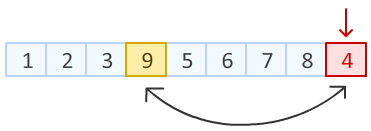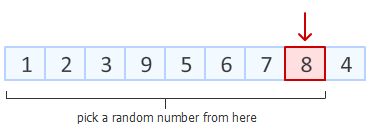|
by
kirupa |
11 May 2011
Have questions? Discuss this Flash / ActionScript tutorial
with others on the forums.
Let's say you have an array whose data is the numbers 1
through 8 stored sequentially as visualized below:

There may be times where you want to shuffle the contents
of this array so that your array's data is more random. You
may want to end up with something like this instead:

In this short tutorial, let's look at the code for taking
the contents of an array and shuffling it.
The approach I use for shuffling the contents of the array
is to use something that
Fisher-Yates
devised and Don Knuth popularized. You'll see later
towards the end of this article why that particular detail
is important.
Anyway, let's go ahead and look at the code:
- public
function
Main()
{
- var
tempArray:Array
= [
1,
2,
3,
4,
5,
6,
7,
8,
9,
10
]
- ShuffleArray(tempArray);
- trace(tempArray);
- }
- public
function
ShuffleArray(input:Array)
- {
- for
(var
i:int
=
input.length-1;
i
>=0;
i--)
- {
- var
randomIndex:int
=
Math.floor(Math.random()*(i+1));
- var
itemAtIndex:Object
=
input[randomIndex];
- input[randomIndex]
=
input[i];
- input[i]
=
itemAtIndex;
- }
- }
The ShuffleArray function, as its name implies, is
responsible for shuffling the contents of your array. To use
it in your code, simply call this function by passing it the
array whose contents you wish to shuffle. After the
ShuffleArray function has run, the array you passed in will
be shuffled. Pretty simple.
If all you wanted was the code to shuffle the contents of
an array in ActionScript 3, you can pretty much stop here.
If you wanted to learn a bit more about how the shuffling
actually works, you should read on. If you had to ask me, I
would strongly suggest you read on because I had a lot of
fun writing it :P
Now that you have seen the code, let's take a step back and
learn more about how our shuffling actually works. Let's
start with the array that we started with:

The first thing we do is start at the end of our
array by selecting our last item:

What we are going to do is swap the contents of our
currently selected item with another item randomly selected
from our array. The range of items I can randomly pick from
are the selected item itself and all items that
precede it:

Let's say that random item that we picked is the one
containing the 4:

Once the random number has been picked, we swap
the contents of our selected item with the randomly
selected item:

With the swap completed, we are done with our last item.
It is time to move on to the next item. Since we are going
through our array backwards, that would be the item that
preceded our last item:

Now, it is time for us to pick another item from our
array to swap with this newly selected item. An important
detail that I want to call out is that the range of numbers
you can randomly pick from no longer includes the last item
you addressed earlier:

The reason for why goes back to what I mentioned earlier
- "The range of items I can randomly pick from are the
selected item itself and all items that precede it."
The random number picked in this iteration is the 2:

Once the random item is picked, we peform the swap with
our selected item. After the swap has been done, this whole
process continues all over again by us moving on to the next
(previous) item:

At the risk of sounding too boring, I am not going to go
any further by dissecting how the rest of the numbers will
get shuffled. The two cases I described should prepare you
well for playing out the remainder of the items.
Now, let's shift our gears to take a look at how our code
helps you to do what was just described.
In
the preceding section, you got an overview of how our
algorithm works. Let's now look at how all of that
translates into code...starting with the ShuffleArray
function:
- public
function
ShuffleArray(input:Array)
- {
- for
(var
i:int
=
input.length-1;
i
>=0;
i--)
- {
- var
randomIndex:int
=
Math.floor(Math.random()*(i+1));
- var
itemAtIndex:Object
=
input[randomIndex];
- input[randomIndex]
=
input[i];
- input[i]
=
itemAtIndex;
- }
- }
The ShuffleArray function takes one argument, and that is
the array that you wish to shuffle. Inside this function,
this array will be called input.
The first thing we will look at is the
for loop:
- for
(var
i:int
=
input.length-1;
i >=0;
i--)
- {
-
var
randomIndex:int
=
Math.floor(Math.random()*(i+1));
-
var
itemAtIndex:Object
=
input[randomIndex];
-
input[randomIndex]
=
input[i];
-
input[i]
=
itemAtIndex;
- }
This loop is responsible for going through every item in
your array and swapping it with a random number. Notice that
the direction of this loop is backwards. You start at the
end of your array (input.length - 1)
and stop at the beginning. The current position you are in
the loop is defined by the i
variable.
You can say that the i
variable refers to the position of the selected item from
our earlier example:

The next step is for us to pick our random number:
- var
randomIndex:int
= Math.floor(Math.random()*(i+1));
- var
itemAtIndex:Object
=
input[randomIndex];
The randomIndex variable
stores the random number mapping to an item's position that
we are interested in. Notice that the maximum value of our
random number is not the array's length, but instead, the
current index position. This matches our expectation that
the random number you can pick is either your selected
element (i) or anything that precedes it.
Once you have your random item position, you can get that
item's contents by simply referring to it in your array:
- var
itemAtIndex:Object
=
input[randomIndex];
At this point, your code corresponds to the following
diagram:

The red arrow corresponds to the position defined by
i, and the item colored in
yellow is your randomly selected item (itemAtIndex).
Once you have your randomly selected item, all that is
left to do is swap their values together:
- input[randomIndex]
=
input[i];
- input[i]
=
itemAtIndex;
The swapping is done by the above two lines where I first
set the item at position i
as the item our randomIndex
position is pointing to. At this very moment, the contents
of input[i] can be found
both at the i position but
also at the randomIndex
position. This is only a temporary problem though.
Earlier, you created a copy of the contents at
input[randomIndex] in your
itemAtIndex variable. This
means you can rectify this problem by setting assigning this
copied value back to input[i].
In fact, that is actually what you do in the last line!
Wohoo! You
just finished learning how to shuffle the contents of an
array. Shuffling algorithms are quite interesting because
there are many ways to shuffle the contents. One thing to
keep in mind is that some algorithms may seem to shuffle the
values, but the shuffling may be heavily biased and uneven.
You don't have to worry about that with the approach I
described here, but if you want to see how easy it is to
make a faulty assumption that seems correct, check out Jeff
Atwood's post titled
The Danger of Naïveté.
Just a final word before we wrap up. What you've seen here is freshly baked content without added preservatives, artificial intelligence, ads, and algorithm-driven doodads. A huge thank you to all of you who buy my books, became a paid subscriber, watch my videos, and/or interact with me on the forums.
Your support keeps this site going! 😇

|